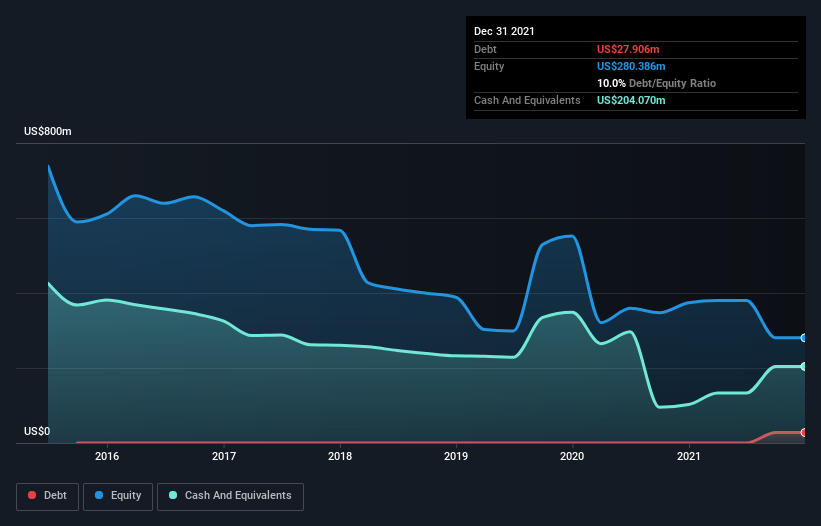Here's Why Karoon Energy (ASX:KAR) Can Manage Its Debt Responsibly
Warren Buffett famously said, 'Volatility is far from synonymous with risk.' It's only natural to consider a company's balance sheet when you examine how risky it is, since debt is often involved when a business collapses. Importantly, Karoon Energy Ltd (ASX:KAR) does carry debt. But the more important question is: how much risk is that debt creating?
When Is Debt Dangerous?
Generally speaking, debt only becomes a real problem when a company can't easily pay it off, either by raising capital or with its own cash flow. In the worst case scenario, a company can go bankrupt if it cannot pay its creditors. While that is not too common, we often do see indebted companies permanently diluting shareholders because lenders force them to raise capital at a distressed price. Of course, debt can be an important tool in businesses, particularly capital heavy businesses. The first step when considering a company's debt levels is to consider its cash and debt together.
View our latest analysis for Karoon Energy
How Much Debt Does Karoon Energy Carry?
As you can see below, at the end of December 2021, Karoon Energy had US$27.9m of debt, up from none a year ago. Click the image for more detail. However, it does have US$204.1m in cash offsetting this, leading to net cash of US$176.2m.
How Healthy Is Karoon Energy's Balance Sheet?
Zooming in on the latest balance sheet data, we can see that Karoon Energy had liabilities of US$129.2m due within 12 months and liabilities of US$693.3m due beyond that. Offsetting this, it had US$204.1m in cash and US$37.0m in receivables that were due within 12 months. So its liabilities total US$581.4m more than the combination of its cash and short-term receivables.
This is a mountain of leverage relative to its market capitalization of US$919.0m. This suggests shareholders would be heavily diluted if the company needed to shore up its balance sheet in a hurry. Despite its noteworthy liabilities, Karoon Energy boasts net cash, so it's fair to say it does not have a heavy debt load!
We also note that Karoon Energy improved its EBIT from a last year's loss to a positive US$105m. When analysing debt levels, the balance sheet is the obvious place to start. But ultimately the future profitability of the business will decide if Karoon Energy can strengthen its balance sheet over time. So if you want to see what the professionals think, you might find this free report on analyst profit forecasts to be interesting.
Finally, a company can only pay off debt with cold hard cash, not accounting profits. Karoon Energy may have net cash on the balance sheet, but it is still interesting to look at how well the business converts its earnings before interest and tax (EBIT) to free cash flow, because that will influence both its need for, and its capacity to manage debt. Over the last year, Karoon Energy actually produced more free cash flow than EBIT. That sort of strong cash generation warms our hearts like a puppy in a bumblebee suit.
Summing up
While Karoon Energy does have more liabilities than liquid assets, it also has net cash of US$176.2m. And it impressed us with free cash flow of US$121m, being 116% of its EBIT. So we don't have any problem with Karoon Energy's use of debt. Of course, we wouldn't say no to the extra confidence that we'd gain if we knew that Karoon Energy insiders have been buying shares: if you're on the same wavelength, you can find out if insiders are buying by clicking this link.
If you're interested in investing in businesses that can grow profits without the burden of debt, then check out this free list of growing businesses that have net cash on the balance sheet.
Have feedback on this article? Concerned about the content? Get in touch with us directly. Alternatively, email editorial-team (at) simplywallst.com.
This article by Simply Wall St is general in nature. We provide commentary based on historical data and analyst forecasts only using an unbiased methodology and our articles are not intended to be financial advice. It does not constitute a recommendation to buy or sell any stock, and does not take account of your objectives, or your financial situation. We aim to bring you long-term focused analysis driven by fundamental data. Note that our analysis may not factor in the latest price-sensitive company announcements or qualitative material. Simply Wall St has no position in any stocks mentioned.

 Yahoo Finance
Yahoo Finance 
